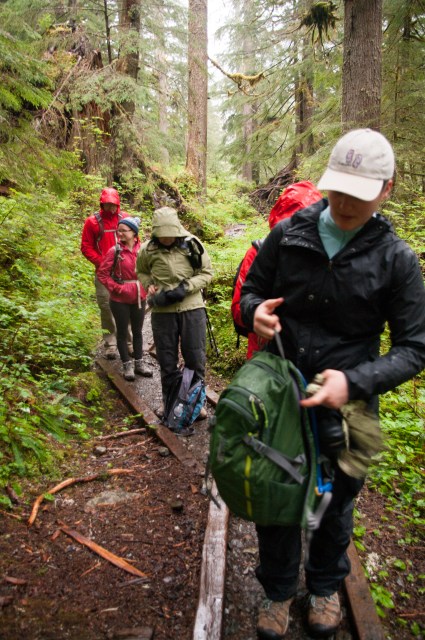 Book Club
Book Club
Phenomena
It’s hard to go into the woods the same way after reading Phenomenal. Every leaf, chirp and rain drop seems like a force of nature, like if I pay attention enough I might feel the earth speaking to me through the souls of my boots, or hear the cloud’s thoughts through a pattern of raindrops. It’s hard to not get the overwhelming feeling that everything is connected, intertwined, full of meaning. There may not be phenomena, per say, on the Barclay Lake Trail, but on this day, everything felt special.

Our small group set off through the dark forest under the cover of hemlock and cedar. As always, we caught up with each other, what adventures we’ve been on, what good books we’ve read, and our upcoming summer plans. We drew up our hoods as the rain became more steady and hopped the growing puddles.

Mist shrouded the outlying mountains and all we could see were trees disappearing into the distance. We came to sense a pattern on the trail of trees taking root in the most unlikely of places. Hundred-foot-tall trees sprouted atop giant boulders, their roots exposed and vulnerable, yet they thrive. If the trail had a phenomena, this was it.

We soon crossed a creek on a log bridge complete with hand rail. The crystal clear water babbled below and I wondered what it was saying. Perhaps it was telling us of its journey from glacier to sea, where it’s been and where it’s going. Or maybe it was just singing to the rocks below thanking them for their strength and navigation.

As we approached the lake I anticipated some recognition of it. I’d been here before, a long time ago. Laura wondered if she had been here before too, when she was a kid with her dad. He works for the Forest Service and had taken her to seemingly all the lakes in the Cascades, but this one she did not recognize, she said. I didn’t recognize it either, yet I know for a fact I’ve been there. I have a spreadsheet that tells me the exact date and who I was with. Yet, I scour for a familiar rock or lake shore and everything tells me I’ve never seen it before. Maybe it’s changed over the years, or maybe I’ve changed and see things differently now that I’m older and (hopefully) wiser.

We found a somewhat covered area on the lake shore to have lunch and discuss the book. Each chapter of Phenomenal is about each of the phenomena that Leigh Ann Henion traveled the world to see. We all chose a favorite (mine was the chapter about Hawaii) and if we could choose one of the phenomena to experience, which would it be (most chose the Northern Lights or the bioluminescence). Finally, we shared our stories of phenomena we had witnessed in our lives or hoped to see one day.

I was thrilled that everyone in the group enjoyed the book because it is one of my very favorite books and has a special place on my bookshelf. Its one of those books that you almost don’t want to share with anyone else because you’re afraid they won’t like it and then it will be a tiny bit ruined for you. But I was really excited to share it with the group and I knew they would all enjoy it. And they did, which made me very happy!

On the way out, we stopped to admire a blanket of false lily-of-the-valley along the trail. I imagined the little green hearts working together in unison to pump life into the forest floor. There was a lone white bunchberry flower rising up amid the lily leaves seemingly declaring its intention to be different. I admired its confidence. Then I wondered what it looks like under the earth with all those roots like the arteries in our bodies. Oh, to walk through the forest with the sense of wonder given to me by this wonderful (you may even say phenomenal) book!


Phenomenal by Leigh Ann Henion
Book Ends
- Watch the teaser trailer for Phenomenal
- Read an interview with Leigh Ann Henion on She-Explores
- Check out my experience watching a total solar eclipse




















































































